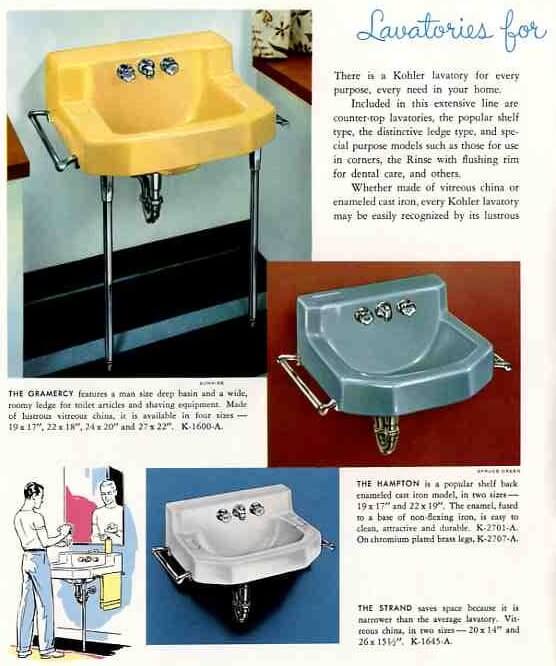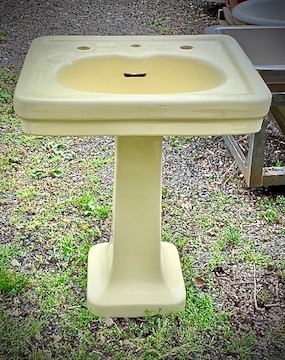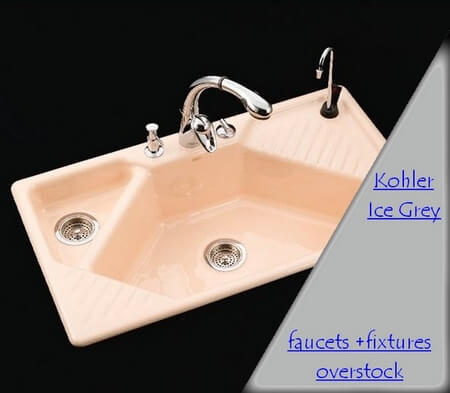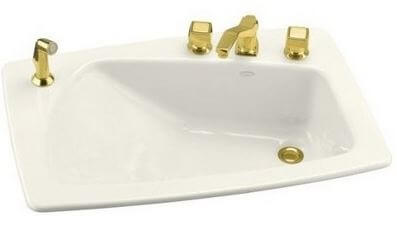Vintage bathroom sinks add a unique charm and character to any bathroom, offering a blend of timeless design and historical appeal. Whether you’re restoring a period home or looking to incorporate vintage elements into a modern space, understanding the various aspects of vintage bathroom sinks can help you make informed decisions. Let’s explore the types, materials, designs, sourcing, restoration, and more to provide a thorough understanding of vintage bathroom sinks.
Types of Vintage Bathroom Sinks
Pedestal Sinks
Pedestal sinks are a classic choice for vintage bathrooms, characterized by a basin that sits atop a tall, slender pedestal. These sinks often feature intricate detailing and elegant lines, making them a focal point in any bathroom. They work well in smaller spaces where storage is not a primary concern, offering a sleek and open feel.
Wall-Mounted Sinks
Wall-mounted sinks are another popular vintage option, often found in mid-century and industrial-style bathrooms. These sinks are attached directly to the wall, freeing up floor space and creating a minimalist look. They can be paired with a variety of vintage faucets and accessories to enhance their retro appeal.
Console Sinks
Console sinks combine the functionality of a pedestal sink with the added benefit of countertop space. They are supported by legs, often made of metal or wood, and provide a practical and stylish solution for vintage bathrooms. The open design of console sinks also allows for additional storage or decorative elements underneath.
Vessel Sinks
Vintage vessel sinks are typically bowl-shaped and sit on top of a vanity or countertop. These sinks are reminiscent of old-fashioned washbasins and add a distinctive touch to any bathroom. They can be made from various materials, including porcelain, glass, and copper, each offering a unique aesthetic.
Drop-In Sinks
Drop-in sinks, also known as self-rimming sinks, are installed with the basin’s rim resting on the countertop. This type of sink was popular in mid-century bathrooms and is easy to install and maintain. Drop-in sinks come in various shapes and materials, making them a versatile choice for vintage bathroom designs.
Undermount Sinks
While not as common in vintage designs, undermount sinks can still be found in some period bathrooms. These sinks are installed beneath the countertop, creating a seamless look. They are often used in conjunction with marble or granite countertops, adding a touch of luxury to the bathroom.

Popular Materials for Vintage Sinks
Porcelain
Porcelain is a quintessential material for vintage bathroom sinks, known for its smooth, glossy finish and durability. It is often used for pedestal, wall-mounted, and console sinks, offering a timeless and classic look. Porcelain sinks are also easy to clean and maintain, making them a practical choice for busy bathrooms.
Enameled Cast Iron
Enameled cast iron sinks are another popular choice for vintage bathrooms. These sinks are incredibly durable and have a glossy enamel finish that resists stains and scratches. The heavy weight of cast iron sinks requires sturdy support, making them ideal for pedestal and console sink designs.
Copper
Copper sinks add a warm, rustic touch to vintage bathrooms. They are often handcrafted and feature unique patinas that develop over time, adding to their charm. Copper is naturally antibacterial and resistant to corrosion, making it a practical and stylish choice for bathroom sinks.
Marble
Marble sinks bring an element of luxury and elegance to vintage bathrooms. They are often found in console and vessel sink designs, showcasing the natural beauty of the stone. Marble requires regular maintenance to prevent staining and etching but offers a timeless appeal that is hard to match.
Glass
Glass sinks, particularly those made from vintage glass, can add a delicate and sophisticated touch to a bathroom. These sinks are typically used as vessel sinks and come in various colors and patterns. While they require careful handling and cleaning, glass sinks can be a stunning addition to a vintage-inspired bathroom.
Vitreous China
Vitreous china sinks are similar to porcelain but with an added layer of vitreous enamel, making them even more durable and glossy. These sinks are common in vintage designs, particularly for pedestal and wall-mounted sinks. The material’s resistance to chipping and scratching makes it a practical choice for high-use bathrooms.
Iconic Vintage Sink Designs from Different Eras
Victorian Era
Victorian-era sinks are known for their ornate designs and intricate detailing. Pedestal sinks from this period often feature floral motifs and elaborate carvings. The use of porcelain and marble was common, reflecting the opulence and elegance of the time.
Art Deco
Art Deco sinks from the 1920s and 1930s are characterized by their bold geometric shapes and sleek lines. These sinks often incorporate materials such as chrome, glass, and enameled cast iron. Console sinks with chrome legs and colorful glass vessel sinks are iconic examples of Art Deco bathroom fixtures.
Mid-Century Modern
Mid-century modern sinks, popular in the 1940s to 1960s, emphasize simplicity and functionality. Wall-mounted and drop-in sinks with clean lines and minimal detailing are typical of this era. Materials such as porcelain and enameled cast iron were commonly used, often in pastel colors.
Industrial
Industrial-style sinks, which became popular in the early 20th century, feature utilitarian designs and durable materials. Wall-mounted sinks with exposed plumbing and metal fixtures are characteristic of this style. The use of materials like cast iron and copper adds to the industrial aesthetic.
Retro
Retro sinks from the 1950s and 1960s often feature vibrant colors and playful designs. Drop-in and wall-mounted sinks in shades of pink, turquoise, and yellow are iconic of this period. The use of enameled cast iron and porcelain was common, with designs reflecting the optimism and energy of the post-war era.
Farmhouse
Farmhouse-style sinks, also known as apron-front sinks, have a rustic and country charm. These sinks are typically made from porcelain, enameled cast iron, or copper and feature a deep basin and exposed front. They are often paired with vintage-style faucets and accessories to complete the farmhouse look.
Sourcing Authentic Vintage Bathroom Sinks
Antique Shops
Antique shops are a great place to start when looking for authentic vintage bathroom sinks. These stores often have a curated selection of period fixtures, including sinks from various eras. Shopping at antique stores allows you to see and inspect the sinks in person before making a purchase.
Architectural Salvage Yards
Architectural salvage yards are treasure troves of vintage fixtures, including bathroom sinks. These yards often source items from old buildings and homes, offering a wide range of styles and materials. Visiting a salvage yard can be an adventure, and you may find unique and rare sinks that add character to your bathroom.
Online Marketplaces
Online marketplaces such as eBay, Etsy, and Craigslist are valuable resources for finding vintage bathroom sinks. These platforms allow you to search for specific styles and eras, often with detailed descriptions and photos. While buying online requires careful consideration of shipping and conditions, it can expand your options significantly.
Reproduction Companies
For those who want the vintage look without the hassle of sourcing an authentic piece, reproduction companies offer high-quality replicas of vintage bathroom sinks. These companies produce sinks that capture the charm and design of original pieces while incorporating modern materials and manufacturing techniques.
Estate Sales and Auctions
Estate sales and auctions can be excellent places to find authentic vintage bathroom sinks. These events often feature items from historical homes and offer the opportunity to purchase unique fixtures. Attending estate sales and auctions can be exciting, and you may find a gem for your bathroom.
Networking with Collectors
Networking with collectors and enthusiasts of vintage bathroom fixtures can also lead to finding authentic sinks. Joining online forums, social media groups, and local collector clubs can provide valuable connections and insights. Collectors often have extensive knowledge and may offer advice or even have items for sale.
Restoration Techniques for Old Sinks
Cleaning and Removing Stains
The first step in restoring an old sink is to clean it thoroughly and remove any stains. For porcelain and enameled cast iron sinks, use a non-abrasive cleaner and a soft cloth to avoid damaging the surface. For tougher stains, a mixture of baking soda and water can be effective. Copper sinks can be cleaned with a mixture of salt and vinegar or a commercial copper cleaner.
Repairing Chips and Cracks
Chips and cracks are common in vintage sinks but can often be repaired. For porcelain and enameled sinks, epoxy putty can be used to fill in chips and cracks, followed by sanding and repainting with a matching enamel paint. For copper sinks, cracks can be soldered and polished to blend with the surrounding material.
Re-enameling
Re-enameling is a process that involves applying a new layer of enamel to an old sink. This technique can restore the glossy finish and protect the sink from further damage. Re-enameling should be done by a professional to ensure a smooth and durable finish.
Polishing and Sealing
Polishing is essential for restoring the shine and luster of vintage sinks. For porcelain and enameled sinks, a specialized polish can be used to enhance the finish. Copper sinks can be polished with a copper cleaner and then sealed with a clear lacquer to prevent tarnishing.
Replacing Hardware
Old sink hardware, such as faucets and handles, may need to be replaced to restore functionality and aesthetics. Vintage-style hardware that matches the era and design of the sink can be sourced from specialty retailers. Ensure that the new hardware is compatible with the sink’s existing plumbing.
Addressing Plumbing Issues
Restoring a vintage sink may also involve addressing plumbing issues, such as replacing old pipes and fittings. It is essential to ensure that the plumbing is up to modern standards to prevent leaks and other problems. Consulting with a professional plumber can help ensure that the restoration is done correctly and safely.
Adapting Vintage Sinks for Modern Plumbing
Assessing Compatibility
Before installing a vintage sink, it is crucial to assess its compatibility with modern plumbing. Vintage sinks may have different drain sizes, faucet configurations, and mounting requirements compared to contemporary sinks. Understanding these differences can help you plan for any necessary adaptations.
Upgrading Drain Assemblies
Vintage sinks may have outdated or incompatible drain assemblies that need to be upgraded. Modern drain assemblies can be fitted to vintage sinks with the help of adapters and fittings. It is essential to ensure that the drain assembly is properly sealed to prevent leaks.
Installing Modern Faucets
While vintage faucets can add authenticity to a vintage sink, they may not always be practical or compatible with modern plumbing. Installing modern faucets with vintage-style designs can provide the best of both worlds. These faucets offer the look of vintage fixtures with the reliability and efficiency of modern plumbing.
Ensuring Proper Venting
Proper venting is crucial for the functionality of any sink, including vintage models. Ensuring that the sink is properly vented can prevent issues such as slow drainage and gurgling noises. Consulting with a professional plumber can help you determine the best venting solution for your vintage sink.
Using Flexible Supply Lines
Flexible supply lines can be a practical solution for connecting vintage sinks to modern plumbing. These lines can accommodate various configurations and make installation easier. They also allow for adjustments if the sink or plumbing needs to be moved or repositioned.
Consulting with Professionals
Adapting a vintage sink for modern plumbing can be complex, and consulting with professionals is often the best approach. Plumbers and contractors with experience in vintage fixtures can provide valuable insights and ensure that the installation is done correctly. Their expertise can help prevent potential issues and ensure that your vintage sink functions properly in your modern bathroom.
Vintage Sink Styles That Complement Different Bathroom Themes
Classic Elegance
For a bathroom theme that emphasizes classic elegance, Victorian and Edwardian-style sinks are ideal. Pedestal sinks with intricate detailing and marble console sinks can enhance the luxurious feel of the bathroom. Pair these sinks with brass or gold hardware and vintage lighting fixtures for a cohesive look.
Rustic Charm
Farmhouse and rustic-themed bathrooms can benefit from the warmth and character of vintage sinks. Apron-front and vessel sinks made from porcelain, copper, or enameled cast iron add to the rustic appeal. Complement these sinks with reclaimed wood vanities, distressed finishes, and vintage accessories.
Industrial Style
Industrial-themed bathrooms can be enhanced with vintage wall-mounted and console sinks. Metal and concrete materials, along with exposed plumbing, contribute to the industrial aesthetic. Pair these sinks with industrial-style lighting, metal mirrors, and minimalist decor for a cohesive look.
Retro Vibes
Retro-themed bathrooms can be brought to life with colorful drop-in and wall-mounted sinks from the 1950s and 1960s. Vibrant hues such as turquoise, pink, and yellow add a playful and nostalgic touch. Combine these sinks with retro-patterned tiles, vintage lighting, and mid-century modern accessories.
Art Deco Glamour
Art Deco-themed bathrooms can be accentuated with sleek and geometric vintage sinks. Console sinks with chrome legs and glass vessel sinks are iconic choices. Pair these sinks with black and white tiles, mirrored surfaces, and bold lighting fixtures for a glamorous look.
Coastal Retreat
For a coastal-themed bathroom, vintage sinks made from natural materials such as porcelain and glass can create a serene and beachy feel. Vessel sinks with a sea glass finish or white porcelain pedestal sinks are ideal choices. Complement these sinks with nautical decor, soft blues and whites, and natural textures.
Mixing Vintage Sinks with Contemporary Bathroom Elements
Integrating vintage sinks into a contemporary bathroom design can create a striking juxtaposition of old and new, adding character and interest to the space.
Contrast and Balance
One approach to mixing vintage sinks with contemporary elements is to focus on contrast and balance. For example, pair a sleek, modern vanity with a vintage pedestal sink to create visual interest. The juxtaposition of clean lines against intricate detailing can create a harmonious balance that highlights both the vintage sink and the contemporary surroundings.
Unified Color Palette
Using a unified color palette can help blend vintage sinks with contemporary elements seamlessly. Choose colors that complement each other, such as neutrals or soft hues, to create a cohesive look. This approach allows the vintage sink to stand out while harmonizing with the overall bathroom design.
Modern Fixtures and Accessories
Incorporating modern fixtures and accessories can update the look of a vintage sink while maintaining its charm. Choose contemporary faucets, lighting fixtures, and hardware that complement the style and era of the vintage sink. This combination of old and new creates a balanced and eclectic aesthetic.
Minimalist Design
Embracing minimalist design principles can highlight the beauty of a vintage sink in a contemporary setting. Opt for clean lines, uncluttered spaces, and streamlined surfaces to allow the vintage sink to become the focal point. This approach emphasizes simplicity and elegance while showcasing the unique qualities of the vintage fixture.
Open Shelving and Storage
Consider incorporating open shelving or storage solutions that complement both the vintage sink and contemporary elements. Floating shelves, sleek cabinets, or minimalist storage units can provide functional storage without overpowering the vintage sink. This integration allows for practicality while maintaining a cohesive design aesthetic.
Statement Pieces
Use statement pieces to enhance the impact of a vintage sink in a contemporary bathroom. This could include a bold mirror, a decorative wall art piece, or a striking wallpaper pattern. By incorporating focal points around the vintage sink, you can create a dynamic and visually engaging space.
Space Considerations for Vintage Sink Installations
Installing a vintage sink requires careful consideration of space to ensure functionality and aesthetics in your bathroom layout.
Assessing Bathroom Size
Before choosing a vintage sink, assess the size and layout of your bathroom. Smaller bathrooms may benefit from pedestal or wall-mounted sinks that conserve floor space. Larger bathrooms can accommodate console or vessel sinks that offer more countertop area and storage options.
Plumbing and Installation Requirements
Vintage sinks may have different plumbing and installation requirements compared to modern fixtures. Ensure that your bathroom can accommodate the necessary plumbing connections and support for the sink. Consult with a plumber or contractor to determine the feasibility of installing a vintage sink in your space.
Accessibility and Use
Consider how the vintage sink will be used on a daily basis and ensure that it meets your functional needs. Pedestal sinks, for example, offer elegance but limited storage space. Console sinks provide more countertop space but require additional support. Choose a sink that balances style with practicality based on your lifestyle and bathroom habits.
Traffic Flow and Clearance
Factor in traffic flow and clearance around the sink area to ensure ease of movement and accessibility. Leave adequate space for opening doors, accessing drawers, and using other bathroom fixtures. Proper clearance ensures a comfortable and functional bathroom environment.
Lighting and Ventilation
Consider how lighting and ventilation will interact with the placement of the vintage sink. Proper lighting enhances the visual appeal of the sink and bathroom while ensuring functionality during daily use. Adequate ventilation helps prevent moisture buildup and maintains the condition of the vintage sink and surrounding materials.
Design Cohesion
Maintain design cohesion throughout the bathroom by integrating the vintage sink with other elements such as countertops, backsplashes, and wall treatments. Choose materials and finishes that complement the sink’s style and era, creating a cohesive and harmonious design scheme.
Vintage Sink Accessories
Enhance the functionality and aesthetics of a vintage sink with carefully chosen accessories that complement its style and era.
Soap Dishes and Dispensers
Vintage-style soap dishes and dispensers add a nostalgic touch to the sink area. Choose designs that coordinate with the sink’s material and finish, such as porcelain, glass, or metal. These accessories provide convenient storage for soap while enhancing the vintage charm of the bathroom.
Towel Bars and Rings
Vintage towel bars and rings contribute to the overall aesthetic of the bathroom while providing practical storage for towels. Opt for styles that reflect the era of the sink, such as ornate Victorian designs or streamlined Art Deco motifs. Position towel bars within easy reach of the sink for convenience.
Mirrors and Vanity Lights
Select mirrors and vanity lights that complement the style and size of the vintage sink. Vintage mirrors with decorative frames or beveled edges add elegance and visual interest. Choose vanity lights that provide ample illumination while enhancing the vintage ambiance of the bathroom.
Faucets and Hardware
Coordinate faucets and hardware with the vintage sink to create a cohesive look. Choose faucets with vintage-inspired designs, such as cross handles or lever handles, that complement the sink’s era. Select hardware finishes, such as brass or chrome, that enhance the sink’s material and finish.
Decorative Accents
Incorporate decorative accents that reflect the vintage style of the sink and enhance the overall ambiance of the bathroom. This could include vintage artwork, ceramic figurines, or botanical prints that evoke the charm of a bygone era. Use accents sparingly to avoid overcrowding the space.
Storage Solutions
Integrate storage solutions that complement the vintage sink without detracting from its aesthetic appeal. Floating shelves, baskets, or vintage cabinets provide additional storage for toiletries, towels, and other bathroom essentials. Choose storage solutions that blend seamlessly with the sink’s design and contribute to a well-organized space.
Related Posts:
- Undermount Bathroom Sink With Faucet Holes
- Moen Bathroom Sink Faucet Parts Diagram
- Moroccan Bathroom Sink
- Trendy Bathroom Sinks
- Bathroom Sink Trap Size
- How To Replace Bathroom Sink Trap
- Bathroom Sink Hose Attachment
- Hammered Nickel Undermount Bathroom Sink
- Kohler Stainless Steel Bathroom Sinks
- How To Build A Bathroom Sink Cabinet








